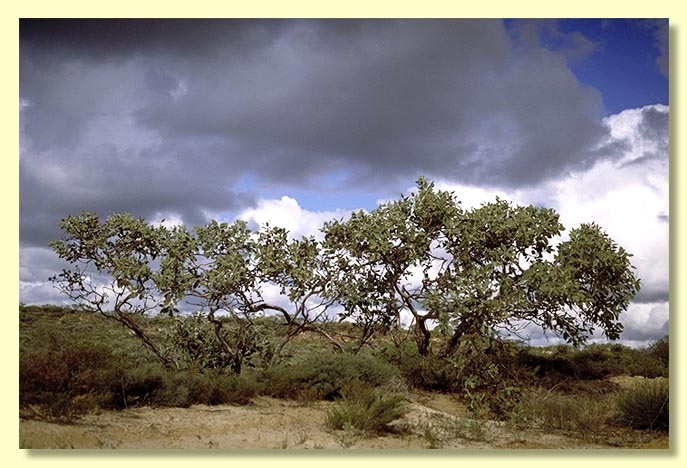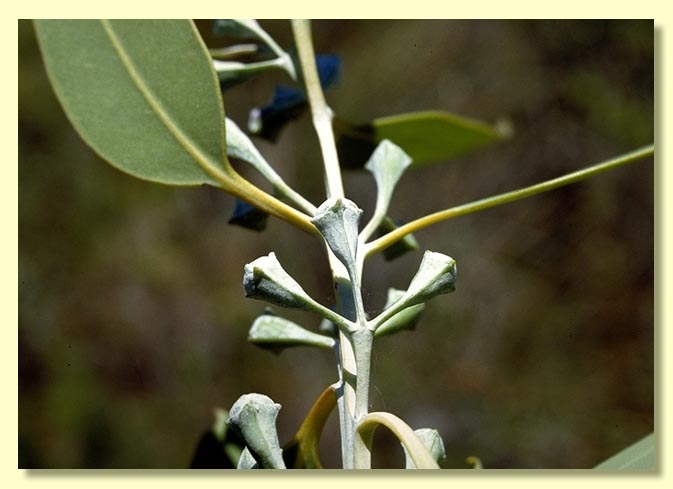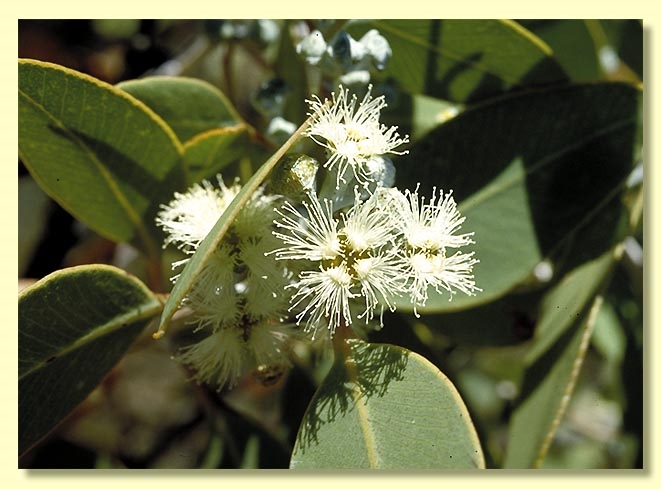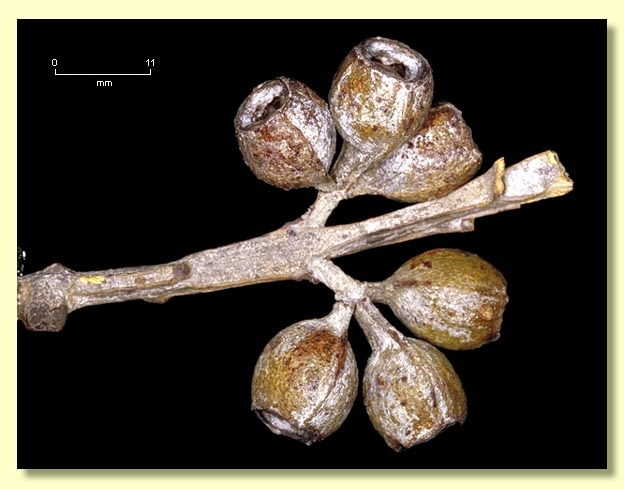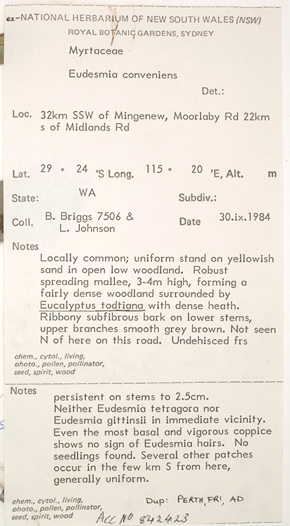Eucalyptus | Eudesmia | Limbatae | Heteropterae | Tetraedrae
Euclid - Online edition
Eucalyptus conveniens
Bark usually smooth, grey-brown over green, sometimes larger mallees with a short stocking of grey-brown ribbony rough bark.
Branchlets glaucous and with oil glands in the pith.
Juvenile growth (coppice or field seedlings to 50 cm): stems square in cross-section, glaucous, lower stem hairy, juvenile leaves petiolate, opposite, ovate to elliptical to oblong, 6.5–9 cm long, 3.5–5.5 cm wide, dull, grey-green to glaucous, apex acute, base lobed to rounded, lamina sometimes hairy on lower leaves, margins sometimes denticulate due to hairs.
Adult leaves opposite to sub-opposite, petioles 1.3–2.5(3) cm long; blade lanceolate to ovate or elliptic, 6–13 cm long, (1.8)2.3–4(5) cm wide, base tapering to petiole, concolorous, dull grey-green to glaucous, side-veins acute, tertiary venation sparse to moderate, intramarginal vein present, oil glands mostly island.
Inflorescence axillary single, peduncles 0.3–1.2 cm long, buds 3 per umbel, pedicels 0.25–0.3 cm long. Mature buds obovoid to pyriform, 1–1.3 cm long, c. 0.5 cm wide, hypanthium more or less four-angled with two opposing angles forming narrow wings, glaucous, outer perianth whorl sepaline, inner whorl operculate, operculum rounded, stamens grouped in four clusters, inflexed, anthers oblong, versatile, dorsifixed, dehiscing by longitudinal slits (non-confluent), style short, stigma tapered, locules usually 3 or 4, the ovules arranged in 4 distinct vertical rows on the placentae, flowers whitish.
Fruit pedicelllate (pedicels 0.25–0.8 cm long), barrel-shaped, 1–2.1 cm long, 0.8–1.2(1.6) cm wide, glaucous (diminishing with age), usually four angled, disc descending, valves 3 or 4 enclosed or near the rim.
Seeds dull brown to blackor geyish, obliquely pyramidal, maybe somewhat flattened, with a ragged flange around the edge, 4–6 mm long, sides ribbed, surface smooth not deeply pitted, hilum ventral/terminal.
Cultivated seedlings (measured at node 10): cotyledons reniform; stems square in cross-section, glaucous, hairy, leaves petiolate, opposite, ovate to elliptical to oblong, 6.5–9 cm long, 3.5–5.5 cm wide, dull grey-green to glaucous, margins denticulate due to hairs, apex acute, base lobed to rounded, lamina hairy.
Flowering has been recorded in January and February.
A low mallee endemic to Western Australia, growing south of Mingenew, from Mt Adams to Badgingarra. The bark is smooth and the leaves of the mature plant are juvenile to intermediate in form, petiolate and grey.
E. conveniens is morphologically intermediate between E. pleurocarpa and E. gittinsii. E. pleurocarpa differs by having glaucous branchlets and wider, ovate to elliptical to broadly lanceolate, shortly petiolate, glaucous leaves. E. gittinsii differs by having non-glaucous branchlets and distinctly petiolate, lanceolate to broadly lanceolate, green adult leaves (not glaucous).
Eucalyptus conveniens belongs in Eucalyptus subgenus Eudesmia, Section Limbatae because of the combination of cotyledons reniform in shape and folded and clasping in embryo, buds with the calyx free and evident as four small teeth around the midline of the bud. (Sections Ebbanoenses and Reticulatae in this subgenus have the calyx fused to the corolla and evident as four small teeth at the apex of the bud.) Within subgenus Eudesmia, section Limbatae, E. conveniens belongs in the series Heteropterae, subseries Tetraedrae, which is further characterised by having seedling leaves with stellate hairs, the presence of oil glands in the pith of the branchlets, stamens arranged in four bundles, flanged ± pyramidal seeds and buds and fruit square in cross-section. The other species in subseries Tetraedrae are E. gittinsii, E. pleurocarpa, E. extrica, E. eudesmioides, E. erythrocorys and E. roycei. E. conveniens is intermediate between E. pleurocarpa and E. gittinsii as discussed above. It can be distinguished from E. extrica by having glaucous leaves and buds (E. extrica not glaucous). E. eudesmioides differs by having smaller leaves, buds and fruit. E. erythrocorys is easily separated by its bright red opercula and yellow flowers, and E. roycei has its buds in groups of seven in each umbel (in groups of three for E. conveniens).

